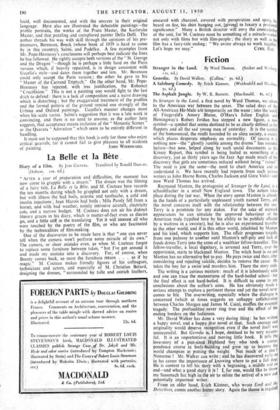Paolo Uccello
The Complete Work of Paolo Uccello. By John Pope-Heunc,.. (Phaidon Press. 3os.) The Complete Work of Paolo Uccello. By John Pope-Heunc,.. (Phaidon Press. 3os.) THE Phaidon Press has earned an immense amount of gratitude for publishing books devoted to the fine arts, attractive and reasonable in price, which combine scholarship with lavish illustration. Occasionally their volumes have fallen below the high standard expected, either on account of a ludicrous translation or by passing for press slight. but irritating misnomers. The present volume has none of these faults, and is certainly one of the niost attractive and useful books they have yet published. Mr. John Pope-Hennessy has prepared and as- sembled his material with skill, though at one or two points. it might seem, with haste ; and his choice of plates and details is altogether admirable, including two delightful toys in the shape of large folding plates, one of the" Monastic Saints " from S. Miniato, and the other of the three-'great battle pieces which together make up " The Rout of San Romano," once in the bedroom of Lorenzo the Magnificent. Coloured plates, those garish distortions beloved by public and publishers, are mercifully restricted to three, well above average, which are in any case duplicated in black and white. Paolo Uccello (1397-1457) is one of the great precursors of Florentine painting, and has always had an assured popularity in this country. This is, however, the first book, written in English, which has been devoted to him. Any study of his work as a painter immediately presents special problems of attribution and rejection. There are no easy delusions for believing his style to be unmistak- able, and 'very little is known of the shadowy figures who were influenced by him. Mr. Pope-Hennessy has of necessity had to appear on a battlefield already thick with conflicting partisan shouts. No result can be decisive, and his opinions will be challenged by the sponsors of one or two attributions he has stamped on, but a fair umpire would agree thathk conclusions must lie very near the truth. The introduction is a straightforward biographical and factual .description of Uccello an his contemporaries in their Florentine setting. The chronology 1§ convincing and the author, with the aid of Mr. John White, has a lucid explanation of the costruziont legittima and the problems of perspective which are so important in an assessment of UccellO's achievement. It is hard, however, to believe that Mr. Pope-Hennessy seriously means what he unexpec. tedly says at the end of 1' last paragraph. An artist cannot be sawn in two, and only %lie part found acceptable, in the ranks of great artists. Uccello can be surely absorbed as a whole without any difficulty, for the " aspiring, compassionate and grave " naturalist of the chiostro verde is completely one with the imaginative decorator of the easel paintings. The critical notes are a model of what such things should be- lucid, well documented, and with the sources in their original language. Here also are illustrated the debatable paintings—the profile portraits, the works of the Prato Master, the Karlsruhe Master, and that puzzling and unexplored painter Dello Delli. The author threads his way with skill through the opinions of his pre- decessors, Berenson, Boeck (whose book of 1939 is hard to come by in this country), Salmi, and Pudelko. A few examples from Mr. Pope-Hennessy's conclusions will perhaps best indicate the lines he has followed. He rightly accepts both versions of the " St. George and the Dragon "—though he is perhaps a little hard on the Paris version which, if heavily repainted, is in design consistent with Uccello's style—and dates them together and late. Mr. Berenson could only accept the Paris version; the other he gave to his " Master of the Carrand Triptych." On the other hand, Mr. Pope- Hennessy has rejected, with less justification, the Rohoncz "Crucifixion." This is not a painting one would fight to the•last ditch to defend : there is a lack of composition and a naive drawing which is disturbing ; but the exaggerated treatment of the profiles and the formal pattern of the ground remind one strongly of the Urbino- and Oxford paintings. Uccello's manner changes most when his scale varies. Salmi's suggestion that it was a late work is convincing, and there is no need to assume, as the author here suggests, that acceptance means inclusion of the " Monastic Scenes " or the Quarata " Adoration " which seem to be entirely different in handling. It must not be supposed that this book is only for those who enjoy critical quarrels, for it cannot fail to give pleasure to all students



































 Previous page
Previous page